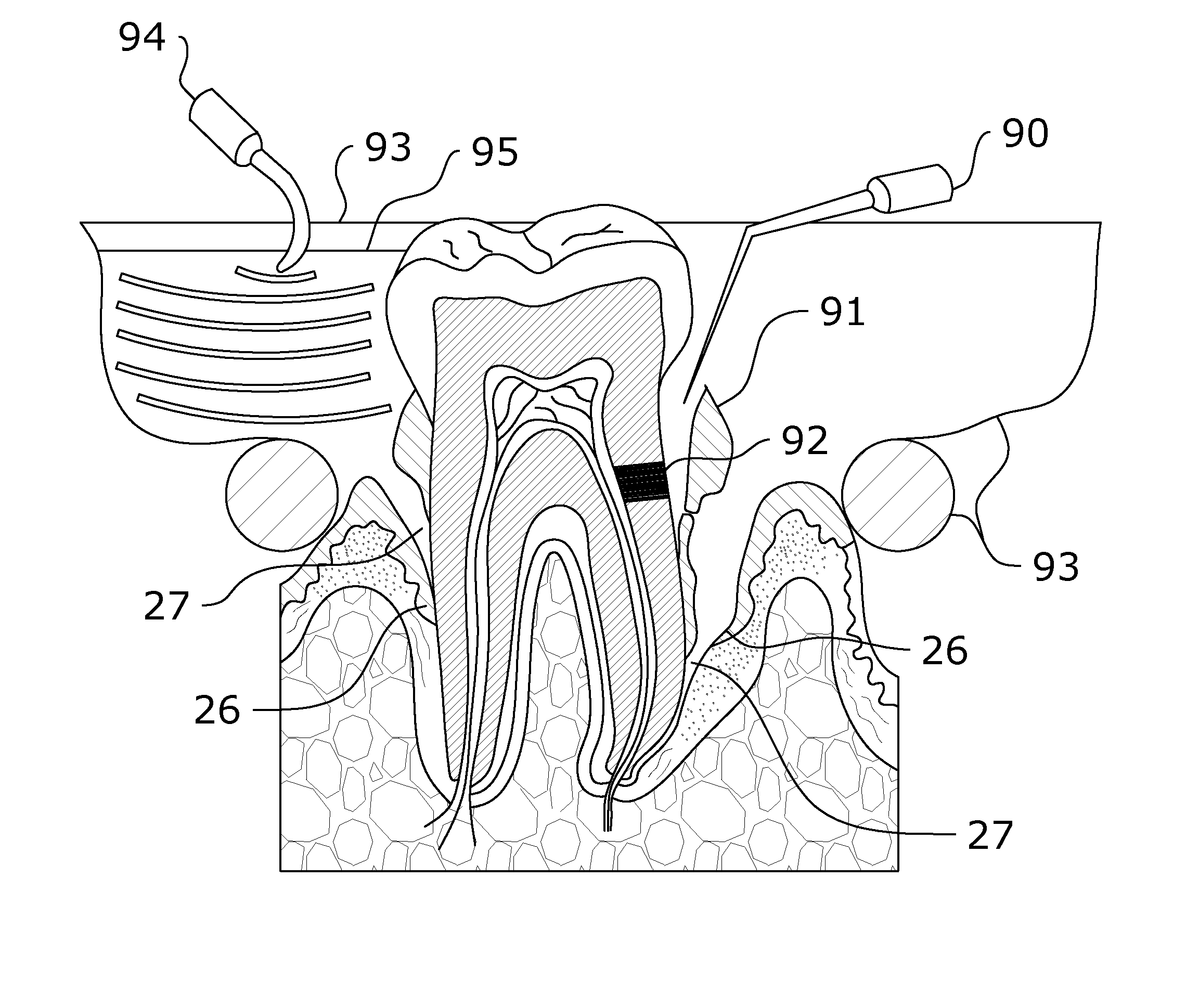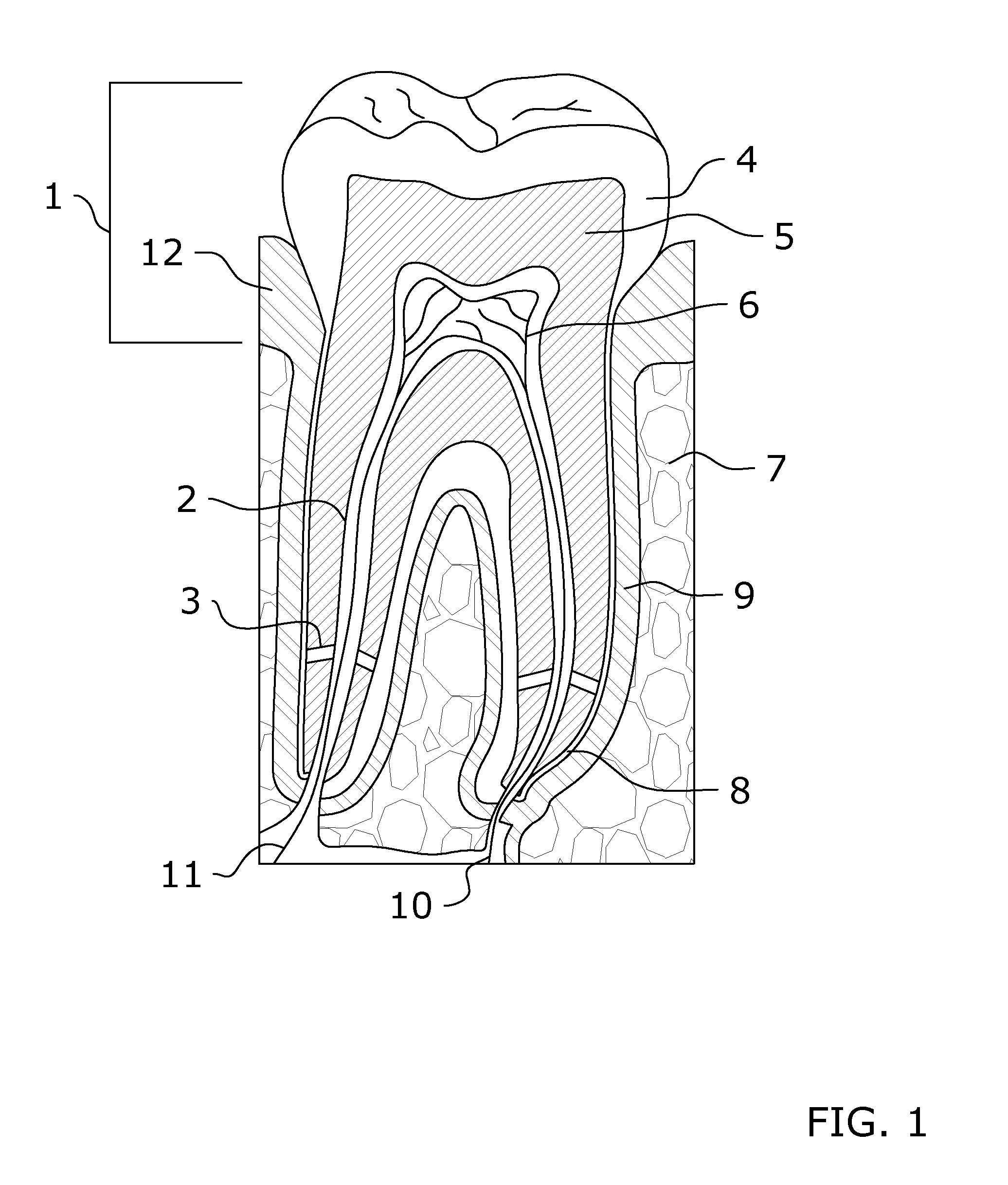There are many problems currently associated with these procedures including but not limited to (1) inadequate disinfecting methods and or solutions regardless of the level of skill with which they are applied, (2) the dangers related to disinfecting solutions that are considered the standard of
dental care, (3) the commercial losses suffered by dentists, and (4) injuries caused to patients as a result of these problems, inadequacies and inefficiencies.
However, plaque that is not removed can harden and form calculus (‘tartar’) that brushing alone cannot clean.
Without a routine cleaning, the
biofilm and the more stubborn tartar will get worse as long as they remain on teeth.
This sanguine swelling, otherwise known as ‘
gingivitis,’ can even cause the affected tissues to bleed if not treated appropriately.
Thus, if
periodontitis is not treated quickly, the bones, gums, and tissue that support the teeth can be severely damaged leading to the possibility of the eventual removal of affected teeth.
In some circumstances teeth can become severely damaged; deep tooth decay, repeated
dental procedures, and / or large fillings, a crack or
chip in the tooth, a trauma to the face, can all cause the tooth nerve and pulp to become irritated, inflamed, and infected.
Without treatment, the tissue surrounding the tooth becomes infected and abscesses may form therein.
Wikipedia describes a typical
root canal therapy process, but fails to disclose the criticality of the rinse cycle as a foundational step in the process, and further fails to discuss the vital importance of disinfecting prior to filling.
The American Dental Association does provides
patient information that describes a six-step
root canal process, but gives only passing mention to disinfecting
irrigation within one step, stating “Medication may be added to the pulp chamber and
root canal(s) to help eliminate
bacteria.” Alarmingly, the ADA fails to provide any guidance to dentists stating: “There is no professional /
clinical information on this topic.”
In
spite the skill and care of the dentist, there is a practical limit to the ability of mechanical instruments to reach all of the tiny periodontal pockets, or the deep root tips during a root canal.
Thus, reaching into the otherwise inaccessible periodontal pockets presents a problem for dentists.
However, the concentration of the irrigants is still a matter of debate and remains controversial, with most advocating around 5.25% to 6% concentration of
sodium hypochlorite, while others advocating a lower concentration.
Despite the modern
standard of care as well as the high understanding of dental
disease and treatment thereof, many patients are injured as a direct result of periodontal or endodontic treatment.
Although his findings delineated in this very old research were highly important, they are still largely ignored by most professional publications and teaching institutions even to the
present day because they were not well
controlled studies.
Thus, many dentists do not know that
bacteria and other infectious organisms are always present in the
dentin tubules after root canal
surgery.
Boyd Haley of the University of Kentucky found that 75% of root canal teeth have residual bacterial infections remaining in the dentinal tubules; thus, these produce
toxic waste that enters the
blood stream causing adverse systemic affects.
Blinding modern dentists to the danger posed to their unsuspecting patients is there inherent belief that the disinfecting substances used to pack the root canal after
surgery effectively sterilizes the root canal site which is unfortunately not true.
Howenstine reported that some dentists are wrongly convinced that the removal of pulp and packing the root canal cavity with a disinfecting substance blocks the supply of nutrients to the
dentin tubules; thus, without the flow nutrients infection cannot be nourished thereby ensuring eradication of infection.
This is simply one example of a systemic medical problem resulting from failure to remove or destroy bacteria in dentine tubules.
Thus, if proper disinfection or cleaning is not done during the procedure there is a high risk of the occurrence of a
bone infection and / or
cyst even after several years.
It should also be understood that failed root canal procedures most often result from
human error, limitations of inadequate tissue removal, and limitations on the state of the art disinfecting solutions.
In this regard, inadequate disinfection can result in a recurring infection, chronic sickness, cysts, and a number of other maladies which the root canal was intended to correct or prevent.
Unfortunately, tissue remnants and infection can be left behind in the root
canal system that has not been treated properly; this because it has been demonstrated that allowing adequate time of
exposure of bacteria to disinfecting solutions is absolutely necessary to eliminate them completely.
Thus as indicated by the aforementioned professionals, many dentists fail to recognize the presence of the
smear layer,
microcrystalline and organic particle debris that is found spread on root canal walls after root canal
instrumentation.
All of this can be made even worse if there are many root canals with curves, as this increases the difficulty of the cleaning and filling process.
These curved spaces complicate the
dental procedure sometimes leading to a tool accidentally penetrating the side of the tooth.
Regardless, this
human error exemplified the criticality of aggressive application of effective disinfecting rinses to prevent the introduction of bacteria into unintended tissue.
This is problematic when a canal is ribbon shaped making the chemical removal of tissue even more important.
Complications may arise if the doctor fails to detect any cracks in the teeth.
Such undetected small cracks may become the gateway for the entry of bacteria and infect the tooth again.
It is also more likely to weaken a tooth and make it more susceptible to cracks if the root canal must be widened mechanically to clean the canal.
Root canal complications may involve the infection of the tooth after root canal treatment, due to defective
dental restoration, broken tools lodged in the canal, lack of microbial
toxin removal, poor obturation, or incomplete disinfection.
Therefore, in summary of root canal failures, those skilled in the art recognize that the current
standard of care results in (a) inadequate time
exposure of bacteria to disinfecting rinses; (b) inadequate penetration of disinfecting solutions into deep or difficult to reach pockets, or primary or transverse canals; (c) ineffectiveness of the disinfecting solutions to kill all the microbes and remove bacterial toxins regardless of the skill with which they are applied; (d) inadequate debridement prior to and after application of the disinfecting rinse; and (e) too much widening and weakening of the root canal
hard tissue structures.
It is also poor at killing viruses and will not remove bacterial toxins such as methyl mercaptan.
It also has a 2% incidence of hypersensitivity reactions in humans, including rare cases of
anaphylactic shock.
When it is used, it is never used at a high enough strength to dissolve and remove
necrotic tissue during root planning, aid in scaling plaque and calculus from tooth surfaces, or to aid in debridement.
The reaction with
ammonia or with substances that can generate
ammonia can produce chloramines which are also toxic and have explosive potential.
Consequences of using the
sodium hypochlorite include accidentally spraying or splashing NaOCl into eyes causing
erosion of and damage to eye tissues.
There are several mishaps present in dental literature that describe root canal
irrigation problems; the most common accidents arising during root canal
irrigation concern damage of the patients' clothing.
Since
sodium hypochlorite is a common household bleaching agent, even small amounts may cause severe damage to clothing.
An all too frequent occurrence is the accidental splashing of NaOCl into the eyes of the doctor or patient, causing immediate pain, profuse watering, intense burning, and
erythema, the possible loss of epithelial cells in the outer layer of the
cornea, severe
irritation, burns, and / or
corrosion that may cause vision impairment and
blurred vision.
Also, accidental splashing or spilling on the
skin causes severe
irritation and burns or dermatitis; thus, prolonged
skin exposure may cause destruction of the
dermis with impairment of the
skin to regenerate at site of contact.
Although concentrations high enough to cause these maladies are not typically used in endodontic or periodontal procedures, the use of NaOCl nevertheless carries all of these risks.
Other disadvantages of
sodium hypochlorite are that it is unstable and that it disintegrates when heated.
While these problems associated with use of NaOCl as a root canal irrigant sound extreme, dental literature documents more extreme dangers of its use, and references many cases where patients were forced to undergo facial
surgery under general
anesthesia to excise
necrotic tissue caused by injected NaOCl, and many weeks of
recovery before being able to resume the root canal procedure.
As is exhaustively described, and is well known to those skilled in the art, the
current practice methods and standard of
dental care employed to treat
periodontal disease, or to perform
endodontic procedures (a) employs the use of highly caustic irrigant solutions that can cause physical injury, hypersensitivity reactions and unintended
tissue damage and discomfort to the patient and their clothes, (b) fails to fully remove bacterial toxins in hard-to-reach areas at a
procedure site, and (c) often times are not adequate in fully disinfecting hard-to-reach deep gingival pockets or root canals of the teeth.
However, the article Lack of
antimicrobial effect on periodontopathic bacteria by ultrasonic and sonic scalers
in vitro.
While the devices were effective in debriding and removing scale and calculus during periodontal procedures, used intraorally, they have no clinically acceptable effect on killing bacteria.
However, foci of this research was simply to determine rinse and ultrasonic frequency combinations to break the bond between the
smear layer and dentinal surface; this did not investigate the correlation between ultrasonic agitation and destruction of bacteria colonies established within the dentinal tubules, transverse root canals, anastomoses, tooth cracks, nor in
abscess pockets that form near the root tips of infected roots.
Although the application of ultrasonic devices during
dental procedures is well known, the use of acoustic delivered
laser energy is much less known in
dentistry.
 Login to View More
Login to View More  Login to View More
Login to View More 


